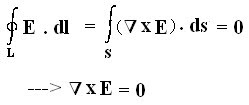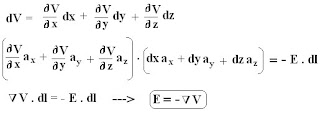Relationship Between Electric Field Intensity(E) & Electric Potential(V) - Field Theory.
- The work done per unit charge in moving a test charge from point A to point B is the electrostatic potential difference between the two points(VAB).
VAB = VB - VA
Similarly,
VBA = VA – VB
- Hence it’s clear that potential difference is independent of the path taken.
Therefore
VAB = - VBA
VAB + VBA = 0
- ∫AB (E . dl) + [ - ∫BA (E . dl) ] = 0
- The above equation shows that the line integral of Electric field intensity (E) along a closed path is equal to zero.
- In simple words,
“No work is done in moving a charge along a closed path in an electrostatic field”.
- Applying Stokes’ Theorem to the above Equation, we have:
- If the Curl of any vector field is equal to zero, then such a vector field is called an Irrotational or Conservative Field.
- Hence an electrostatic field is also called a conservative field.
- The above equation is called the second Maxwell’s Equation of Electrostatics.
- Since Electric potential is a scalar quantity, hence dV (as a function of x, y and z variables) can be written as:
- Hence the Electric field intensity (E) is the negative gradient of Electric potential (V).
- The negative sign shows that E is directed from higher to lower values of V i.e. E is opposite to the direction in which V increases.
EQUIPOTENTIAL SURFACE:
- An equipotential surface refers to a surface where the potential is constant.
- The intersection of an equipotential surface and a plane results into a path called an equipotential line.
- No work is done in moving a charge from one point to the other along an equipotential line or surface i.e. VA – VB = 0
Hence,
From the above equation, it’s clear that the electric flux lines and the equipotential surface and normal to each other.
- Because the electric field is the negative gradient of electric potential, the electric field lines are everywhere normal to the equipotential surface and points in the direction of decreasing potential.
- The equipotential lines for a positive point charge. The solid lines show the flux lines or electric lines of force.
To Download This Page: Click Here
ALSO READ:
- Gauss's Law - Theory.
- Gauss's Law - Application To a Point charge.
- Gauss's Law - Application To An Infinite Line Charge.
- Gauss's Law - Application To An Infinite Sheet Charge.
- Gauss's Law - Application To a Uniformly Charged Sphere.
- Numericals / Solved Examples - Gauss's Law.
- Scalar Electric Potential / Electrostatic Potential (V).
- Relationship Between Electric Field Intensity (E) and Electrostatic Potential (V).
- Electric Potential Due To a Circular Disk.
- Electric Dipole.
- Numericals / Solved Examples - Electric Potential and Electric Dipole.
- Energy Density In Electrostatic Field / Work Done To Assemble Charges.
- Numericals / Solved Examples - Electrostatic Energy and Energy Density.
- Numericals / Solved Examples - Gauss's law...
- Short Notes/FAQ's
Your suggestions and comments are welcome in this section. If you want to share something or if you have some stuff of your own, please do post them in the comments section.







nice
ReplyDeletegood work
ReplyDeleteWould you say that E=V/r is a fair statement? Doing a problem involving two spheres with equal charge, but different radii connected by a wire. The E was found by using V/r which doesn't make sense to me! Please explain how this could EVER be seeing as E=kq/r^2 and V=kq/r
ReplyDelete